Pore Structure and Fractal Characteristics of the Middle and Upper Permian Dalong and Gufeng Shale Reservoirs, Western Hubei Province, South China
Abstract
:1. Introduction
2. Geological Setting
3. Methodology
3.1. Samples
3.2. Analytical Methods
4. Results
4.1. TOC Content and Bulk Mineralogy
4.2. Lithofacies Classification
4.2.1. Siliceous Mudstone
4.2.2. Calcareous–Siliceous Mixed Mudstone
4.2.3. Argillaceous–Siliceous Mixed Mudstone
4.2.4. Carbonaceous Mudstone
4.3. Pore Types from FE-SEM Observations
4.4. Pore Structure Parameters Obtained from Gas Adsorption Analysis
4.5. Fractal Dimensions from N2 Adsorption Isotherms
5. Discussion
5.1. The Influence of OM on Pore Structure
5.2. The Control of Mineralogy on Pore Structure
5.3. Relationships between Fractal Dimensions and Pore Structure Parameters
5.4. Relationships between Fractal Dimensions and Bulk Compositions
6. Conclusions
- (1)
- Based on TOC content, mineral compositions, rock texture, and fabric, four mudstone lithofacies are identified in the Dalong and Gufeng Formations, primarily consisting of siliceous mudstone, calcareous–siliceous mixed mudstone, argillaceous–siliceous mixed mudstone, and carbonaceous mudstone. Stratigraphically, silica-rich mudstone is predominantly distributed in the lower part of the Dalong Formation and Gufeng Formation, and the lithofacies gradually evolve into mixed mudstone upward.
- (2)
- The pore types are dominated by interparticle pores between matrix minerals, slit-shaped pores between clay flakes, and nanometer-sized OM pores in the Dalong and Gufeng Formations. The pore size distribution is predominantly characterized by a diameter of <30 nm, which is the primary contributor to total pore volume. The siliceous mudstone and carbonaceous mudstone are considered to be potential target lithofacies in the study area due to their high total porosity.
- (3)
- The pore development of the Dalong and Gufeng Formations is primarily influenced by both OM content and clay mineral content. The siliceous mudstone shale with high TOC content generally displays high pore volume. The moderate content of clay minerals promotes pore development due to silt-like pores between clay sheets. However, the weakly negative correlation between total pore volume and carbonate content suggests a negative impact of carbonate minerals on total porosity, which is ascribed to the presence of abundant pore-filling carbonate cement.
- (4)
- The pore structure of the Dalong and Gufeng Formations exhibits fractal characteristics based on the FHH model, indicating the irregularity and complexity of the pore structure. The pore heterogeneity is predominantly controlled by micropores, and, to a lesser degree, mesopores, displaying large fractal dimensions (D1, D2) in the range of relatively small pore diameters. The OM and carbonate minerals content exerts a dominant control on fractal dimensions, leading to enhanced heterogeneity of the pore structure.
Author Contributions
Funding
Data Availability Statement
Acknowledgments
Conflicts of Interest
References
- Curtis, J.B. Fractured shale-gas systems. AAPG Bull. 2002, 86, 1921–1938. [Google Scholar]
- Jarvie, D.M.; Hill, R.J.; Ruble, T.E.; Pollastro, R.M. Unconventional shale-gas systems: The Mississippian Barnett shale of north-central Texas as one model for thermogenic shale-gas assessment. AAPG Bull. 2007, 91, 475–499. [Google Scholar] [CrossRef]
- Hao, F.; Zou, H.; Lu, Y. Mechanisms of shale gas storage: Implications for shale gas exploration in China. AAPG Bull. 2013, 91, 475–499. [Google Scholar] [CrossRef]
- Zou, C.; Zhu, R.; Chen, Z.-Q.; Ogg, J.G.; Wu, S.; Dong, D.; Qiu, Z.; Wang, Y.; Wang, L.; Lin, S.; et al. Organic-matter-rich shales of China. Earth-Sci. Rev. 2019, 189, 51–78. [Google Scholar] [CrossRef]
- Chalmers, G.; Bustin, R.; Power, I. Characterization of gas shale pore systems by porosimetry, pycnometry, surface area, and field emission scanning electron microscopy/transmission electron microscopy image analyses: Examples from the Barnett, Woodford, Haynesville, Marcellus, and Doig units. AAPG Bull. 2012, 96, 1099–1119. [Google Scholar]
- Loucks, R.G.; Reed, R.M.; Ruppel, S.C.; Hammes, U. Spectrum of pore types and networks in mudrocks and a descriptive classification for matrix-related mudrock pores. AAPG Bull. 2012, 96, 1071–1098. [Google Scholar] [CrossRef]
- Mastalerz, M.; Schimmelmann, A.; Drobniak, A.; Chen, Y. Porosity of Devonian and Mississippian New Albany Shale across a maturation gradient: Insights from organic petrology, gas adsorption, and mercury intrusion. AAPG Bull. 2013, 97, 1621–1643. [Google Scholar] [CrossRef]
- Milliken, K.L.; Rudnicki, M.; Awwiller, D.N.; Zhang, T. Organic matter-hosted pore system, Marcellus Formation (Devonian), Pennsylvania. AAPG Bull. 2013, 97, 177–200. [Google Scholar] [CrossRef]
- Ko, L.T.; Loucks, R.G.; Zhang, T.; Ruppel, S.C.; Shao, D. Pore and pore network evolution of Upper Cretaceous Boquillas (Eagle Ford–equivalent) mudrocks: Results from gold tube pyrolysis experiments. AAPG Bull. 2016, 100, 1693–1722. [Google Scholar] [CrossRef]
- Dong, T.; Harris, N.B.; Ayranci, K.; Twemlow, C.E.; Nassichuk, B.R. Porosity characteristics of the Devonian Horn River shale, Canada: Insights from lithofacies classification and shale composition. Int. J. Coal Geol. 2015, 141–142, 74–90. [Google Scholar] [CrossRef]
- Pommer, M.; Milliken, K. Pore types and pore-size distributions across thermal maturity, Eagle Ford Formation, southern Texas. AAPG Bull. 2015, 99, 1713–1744. [Google Scholar] [CrossRef]
- Katz, B.J.; Arango, I. Organic porosity: A geochemist’s view of the current state of understanding. Org. Geochem. 2018, 123, 1–16. [Google Scholar] [CrossRef]
- Liu, B.; Schieber, J.; Mastalerz, M. Combined SEM and reflected light petrography of organic matter in the New Albany Shale (Devonian-Mississippian) in the Illinois Basin: A perspective on organic pore development with thermal maturation. Int. J. Coal Geol. 2017, 184, 57–72. [Google Scholar] [CrossRef]
- Mastalerz, M.; Drobniak, A.; Stankiewicz, A. Origin, properties, and implications of solid bitumen in source-rock reservoirs: A review. Int. J. Coal Geol. 2018, 195, 14–36. [Google Scholar] [CrossRef]
- Milliken, K.L.; Olson, T. Silica Diagenesis, Porosity Evolution, and Mechanical Behavior In Siliceous Mudstones, Mowry Shale (Cretaceous), Rocky Mountains, USA. J. Sediment. Res. 2017, 87, 366–387. [Google Scholar] [CrossRef]
- Dong, T.; He, S.; Chen, M.; Hou, Y.; Guo, X.; Wei, C.; Han, Y.; Yang, R. Quartz types and origins in the paleozoic Wufeng-Longmaxi Formations, Eastern Sichuan Basin, China: Implications for porosity preservation in shale reservoirs. Mar. Pet. Geol. 2019, 106, 62–73. [Google Scholar] [CrossRef]
- Mandelbrot, B.B. Fractals in physics-squig clusters, diffusions, fractal measures, and the unicity of fractal dimensionality. J. Stat. Phys. 1984, 34, 895–930. [Google Scholar] [CrossRef]
- Mandelbrot, B.B. Self-affine fractals and fractal dimension. Phys. Scr. 1985, 32, 257–260. [Google Scholar] [CrossRef]
- Yang, R.; He, S.; Yi, J.; Hu, Q. Nano-scale pore structure and fractal dimension of organic-rich Wufeng-Longmaxi shale from Jiaoshiba area, Sichuan Basin: Investigations using FE-SEM, gas adsorption and helium pycnometry. Mar. Pet. Geol. 2016, 70, 27–45. [Google Scholar] [CrossRef]
- Shao, X.; Pang, X.; Li, Q.; Wang, P.; Chen, D.; Shen, W.; Zhao, Z. Pore structure and fractal characteristics of organic-rich shales: A case study of the lower Silurian Longmaxi shales in the Sichuan Basin, SW China. Mar. Pet. Geol. 2017, 80, 192–202. [Google Scholar] [CrossRef]
- Peng, N.; He, S.; Hu, Q.; Zhang, B.; He, X.; Zhai, G.; He, C.; Ynag, R. Organic nanopore structure and fractal characteristics of Wufeng and lower member of Longmaxi shales in southeastern Sichuan, China. Mar. Pet. Geol. 2019, 103, 456–472. [Google Scholar] [CrossRef]
- Ahmad, A.L.; Mustafa, N.N. Pore surface fractal analysis of palladium-alumina ceramic membrane using frenkel-Halsey-Hill (FHH) model. J. Colloid Interface Sci. 2006, 301, 575–584. [Google Scholar] [CrossRef] [PubMed]
- Yao, Y.; Liu, D.; Tang, D.; Tang, S.; Huang, W. Fractal characterization of adsorption-pores of coals from North China: An investigation on CH4 adsorption capacity of coals. Int. J. Coal Geol. 2008, 73, 27–42. [Google Scholar] [CrossRef]
- Li, A.; Ding, W.; He, J.; Dai, P.; Yin, S.; Xie, F. Investigation of pore structure and fractal characteristics of organic-rich shale reservoirs: A case study of Lower Cambrian Qiongzhusi formation in Malong block of eastern Yunnan Province, South China. Mar. Pet. Geol. 2016, 70, 46–57. [Google Scholar] [CrossRef]
- Wang, W.; Shi, W.; Fu, X. Shale gas exploration potential and target of Permian Dalong Formation in northern Sichuan. Prtroleum Geol. Exp. 2020, 42, 892–899. [Google Scholar]
- Xie, T.; Pan, S.; Wang, Y.; Ren, Z.; Yu, J.; Duan, K. Analysis on main controlling factors of shale gas enrichment in Upper Permian Dalong Formation in Well Endi 1, Western Hubei. Resour. Environ. Eng. 2022, 36, 149–153. [Google Scholar]
- Jiang, P.; Wu, J.; Zhu, Y.; Zhang, D.; Wu, W.; Zhang, R.; Wu, J.; Wang, Q.; Yang, Y.; Yang, X.; et al. Enrichment conditions and favorable areas for exploration and development of marine shale gas in Sichuan Basin. Acta Pet. Sin. 2023, 44, 91–109. [Google Scholar]
- Duan, K.; Xie, T.; Wang, Y.; Zhang, Y.; Shi, W.; Lu, Y. Reservoir Characteristics and Their Controlling Factors in Siliceous Shales of the Upper Permian Dalong Formation, Western Hubei Province, South China. Appl. Sci. 2023, 13, 1434. [Google Scholar] [CrossRef]
- Yin, H.; Jiang, H.; Xia, W.; Fegn, Q.; Zhang, N.; Shen, J. The end-Permian regression in South China and its implication on mass extinction. Earth-Sci. Rev. 2014, 137, 19–33. [Google Scholar] [CrossRef]
- Zhai, G.; Wang, Y.; Liu, G.; Zhou, Z.; Zhang, C.; Liu, X. Enrichment and accumulation characteristics and prospect analysis of the Permian marine conticental multiphase shale gas in China. Sediment. Geol. Tethyan Geol. 2020, 40, 102–117. [Google Scholar]
- Liu, W.; Qiao, Y.; Bo, J.; Mou, C.; Tong, J.; Yao, J. Geochemistry of mudstones from the Upper Permian Dalong Formation in the Enshi area, western Hubei, and its implications for weathering, provenance and tectonic setting. J. Lanzhou Univ. Nat. Sci. 2019, 55, 158–167. [Google Scholar]
- Luo, W.; Hou, M.; Liu, X.; Huang, S.; Chao, H.; Zhang, R.; Deng, X. Geological and geochemical characteristics of marine-continental transitional shale from the Upper Permian Longtan formation, Northwestern Guizhou, China. Mar. Pet. Geol. 2018, 89, 58–67. [Google Scholar] [CrossRef]
- He, Q.; Dong, T.; He, S.; Zhai, G. Methane adsorption capacity of marine-continental transitional facies shales: The case study of the Upper Permian Longtan Formation, northern Guizhou Province, Southwest China. J. Pet. Sci. Eng. 2019, 183, 106406. [Google Scholar] [CrossRef]
- Thommes, M.; Kaneko, K.; Neimark, A.V.; Olivier, J.P.; Rodriguez-Reinoso, F.; Rouquerol, J.; Sing, K.S.W. Physisorption of gases, with special reference to the evaluation of surface area and pore size distribution (IUPAC Technical Report). Pure Appl. Chem. 2015, 87, 1051–1069. [Google Scholar] [CrossRef]
- Jarniec, M. Evaluation of the fractal dimension form a single adsorption isotherm. Langmuir 1995, 11, 2316–2317. [Google Scholar] [CrossRef]
- Yang, F.; Ning, Z.; Liu, H. Fractal characteristics of shales from a shale gas reservoir in the Sichuan Basin, China. Fuel 2014, 115, 378–384. [Google Scholar] [CrossRef]
- Delle, P.C.; Bourdet, J.; Josh, M.; Clennell, M.B.; Rickard, W.D.A.; Saunders, M.; Sherwood, N.; Li, Z.; Dewhurst, D.N.; Raven, M.D. Organic matter network in post-mature Marcellus Shale: Effects on petrophysical properties. AAPG Bull. 2018, 102, 2305–2332. [Google Scholar] [CrossRef]
- Dong, T.; Harris, N.B.; McMillan, J.M.T.; Twemlow, C.E.; Nassichuk, B.R.; Bish, D.l. A model for porosity evolution in shale reservoirs: An example from the Upper Devonian Duvernay Formation, Western Canada Sedimentary Basin. AAPG Bull. 2019, 103, 1017–1044. [Google Scholar] [CrossRef]
- Curtis, M.E.; Cardott, B.J.; Sondergeld, C.H.; Rai, C.S. Development of organic porosity in the Woodford Shale with increasing thermal maturity. Int. J. Coal Geol. 2012, 103, 26–31. [Google Scholar] [CrossRef]
- Ardakani, O.H.; Sanei, H.; Ghanizadeh, A. Do all fractions of organic matter contribute equally in shale porosity? A case study from Upper Ordovician Utica Shale, southern Quebec, Canada. Mar. Pet. Geol. 2018, 92, 794–808. [Google Scholar] [CrossRef]
- Misch, D.; Klaver, J.; Gross, D. Factors controlling shale microstructure and porosity: A case study on upper Visean Rudov beds from the Ukrainian Dneiper–Donets Basin. AAPG Bull. 2018, 102, 2629–2654. [Google Scholar] [CrossRef]
- Misch, D.; Gross, D.; Hawranek, G. Solid bitumen in shales: Petrographic characteristics and implications for reservoir characterization. Int. J. Coal Geol. 2019, 205, 14–31. [Google Scholar] [CrossRef]
- Knapp, L.J.; Ardakani, O.H.; Uchida, S. The influence of rigid matrix minerals on organic porosity and pore size in shale reservoirs: Upper Devonian Duvernay Formation, Alberta, Canada. Int. J. Coal Geol. 2020, 227, 103525. [Google Scholar] [CrossRef]
- Wang, Y.; Bai, L.; Zhang, Y. Reservoir Characteristics and Influencing Factors of Organic-Rich Siliceous Shale of the Upper Permian Dalong Formation in Western Hubei. Energies 2023, 16, 5130. [Google Scholar] [CrossRef]
- Ko, L.T.; Ruppel, S.C.; Loucks, R.G. Pore-types and pore-network evolution in Upper Devonian-Lower Mississippian Woodford and Mississippian Barnett mudstones: Insights from laboratory thermal maturation and organic petrology. Int. J. Coal Geol. 2018, 190, 3–28. [Google Scholar] [CrossRef]
- Peng, J.; Milliken, K.L.; Fu, Q. Quartz types in the Upper Pennsylvanian organic-rich Cline Shale (Wolfcamp D), Midland Basin, Texas: Implications for silica diagenesis, porosity evolution and rock mechanical properties. Sedimentology 2020, 67, 2040–2064. [Google Scholar] [CrossRef]
- Qiu, Z.; Liu, B.; Dong, D.; Lu, B.; Yawar, Z.; Chen, Z.; Schieber, J. Silica diagenesis in the Lower Paleozoic Wufeng and Longmaxi Formations in the Sichuan Basin, South China: Implications for reservoir properties and paleoproductivity. Mar. Pet. Geol. 2020, 121, 104594. [Google Scholar] [CrossRef]
- Zhao, J.; Jin, Z.; Jin, Z.; Wen, X.; Geng, Y. Origin of authigenic quartz in organic-rich shales of the Wufeng and Longmaxi Formations in the Sichuan Basin, South China: Implications for pore evolution. J. Nat. Gas Sci. Eng. 2017, 38, 21–38. [Google Scholar] [CrossRef]
- Bustin, R.M.; Bustin, A.M.M.; Cui, X.; Ross, D.J.K.; Pathi, V.S.M. Impact of Shale Properties on Pore Structure and Storage Characteristics. In Proceedings of the SPE Shale Gas Production Conference, Fort Worth, TX, USA, 16–18 November 2008. [Google Scholar]
- Liu, B.; Mastalerz, M.; Schieber, J. Petrophysical property variations in overmature Marcellus Shale: Impliations for gas storage and producibility. AAPG Bull. 2023, 107, 685–716. [Google Scholar] [CrossRef]
- Zhang, J.; Li, X.; Xie, Z.; Li, J.; Zhang, X.; Sun, K.; Wang, F. Characterization of microscopic pore types and structures in marine shale: Examples from the Upper Permian Dalong formation, Northern Sichuan Basin, South China. J. Nat. Gas Sci. Eng. 2018, 59, 326–342. [Google Scholar] [CrossRef]
- Wu, Z.; He, S.; Li, X.; Liu, X.; Zhai, G.; Huang, Z.; Yang, W. Comparative study on pore structure characteristics of marine and transitional facies shales: A case study of the Upper Permian Longtan Formation and Dalong Formation in the Lower Yangtze area, south China. J. Pet. Sci. Eng. 2022, 215, 110578. [Google Scholar] [CrossRef]
- Yang, C.; Zhang, J.; Wang, X.; Tang, X.; Chen, Y.; Jiang, L.; Gong, X. Nanoscale pore structure and fractal characteristics of a marine-continental transitional shale: A case study from the lower Permian Shanxi Shale in the southeastern Ordos Basin, China. Mar. Pet. Geol. 2017, 88, 54–68. [Google Scholar] [CrossRef]
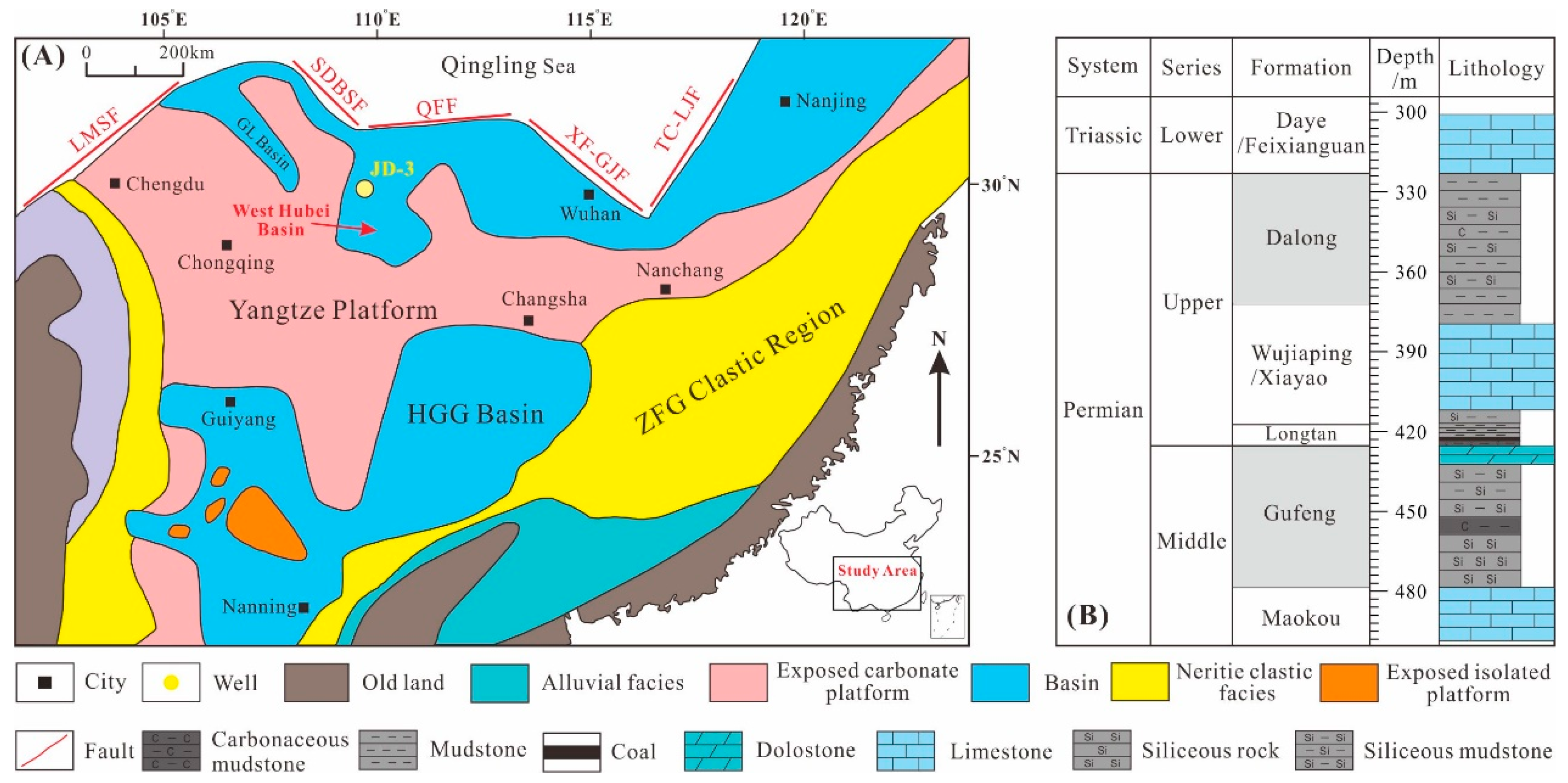
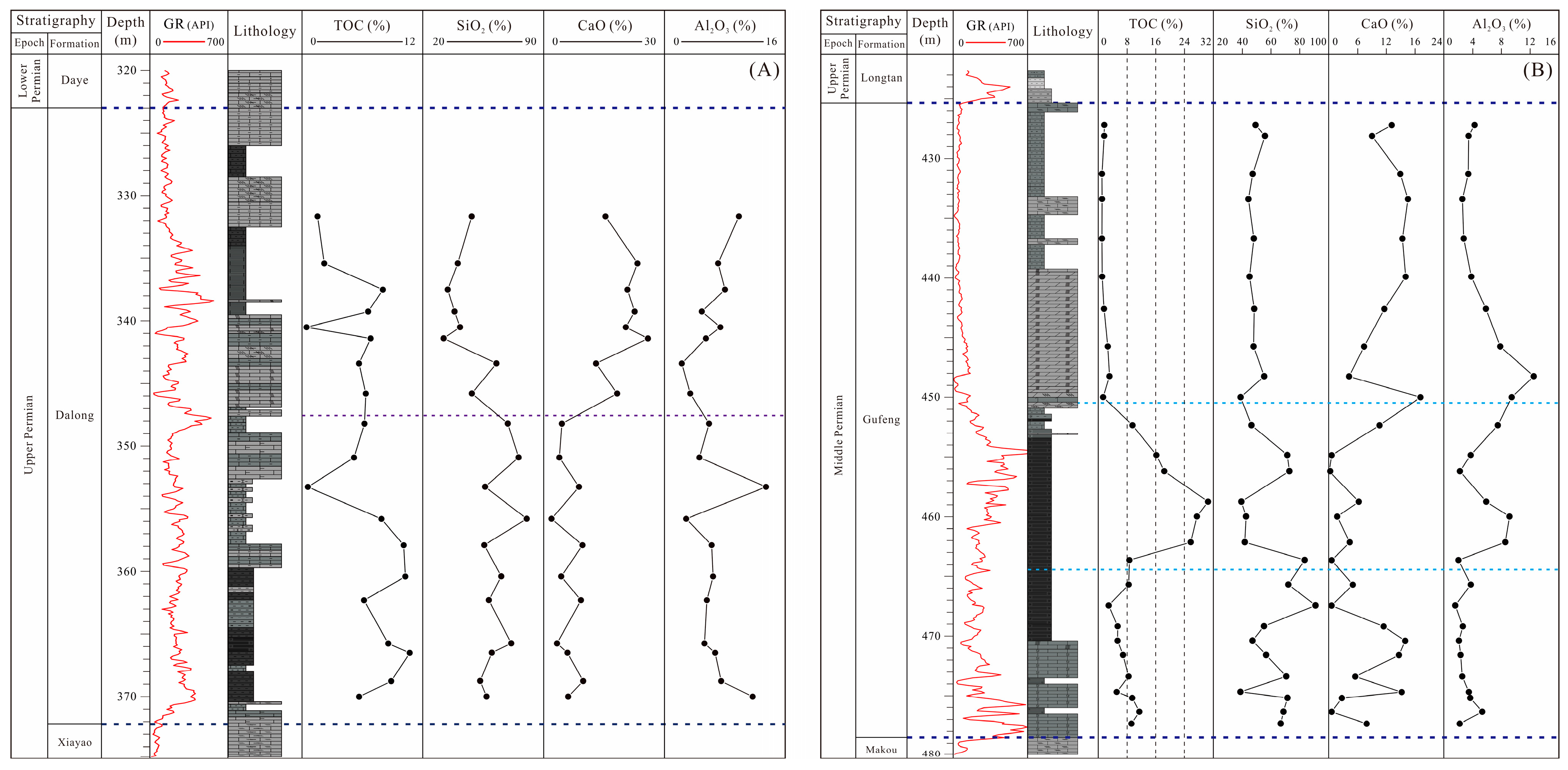
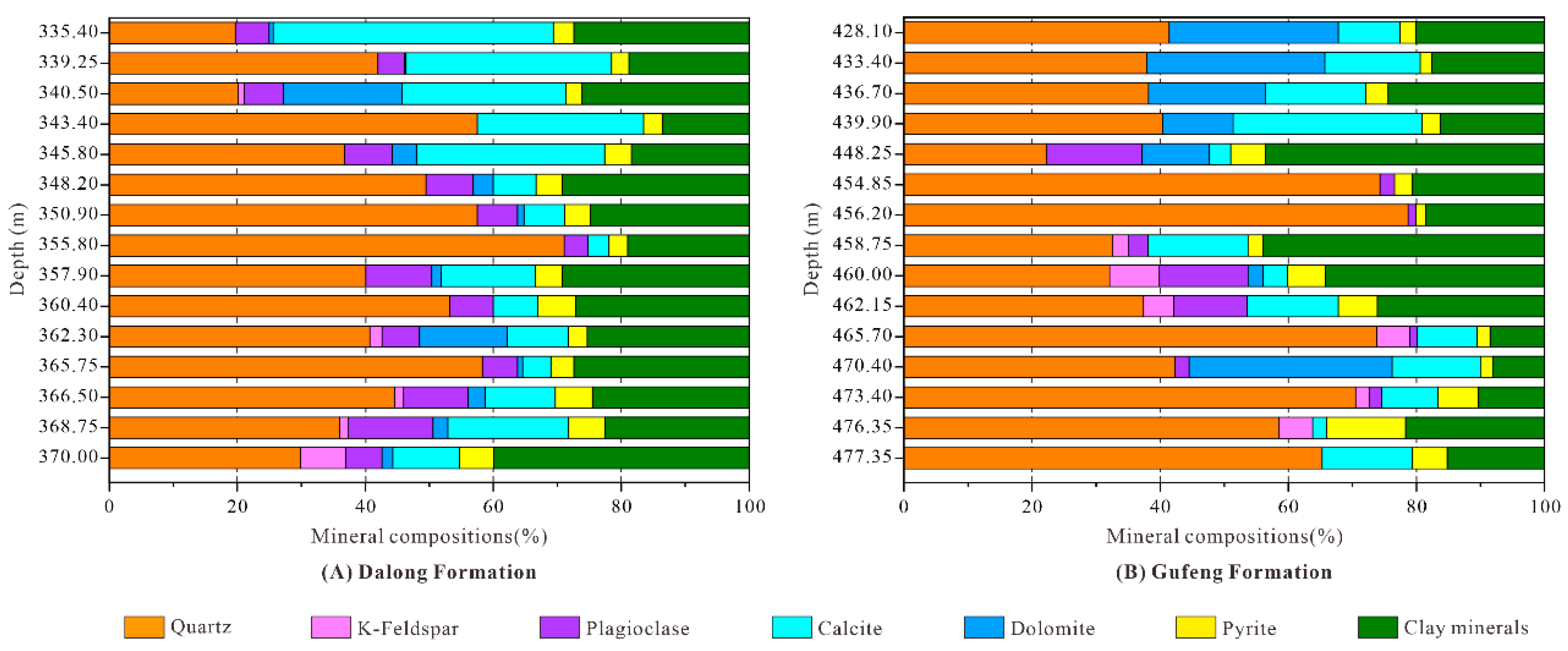
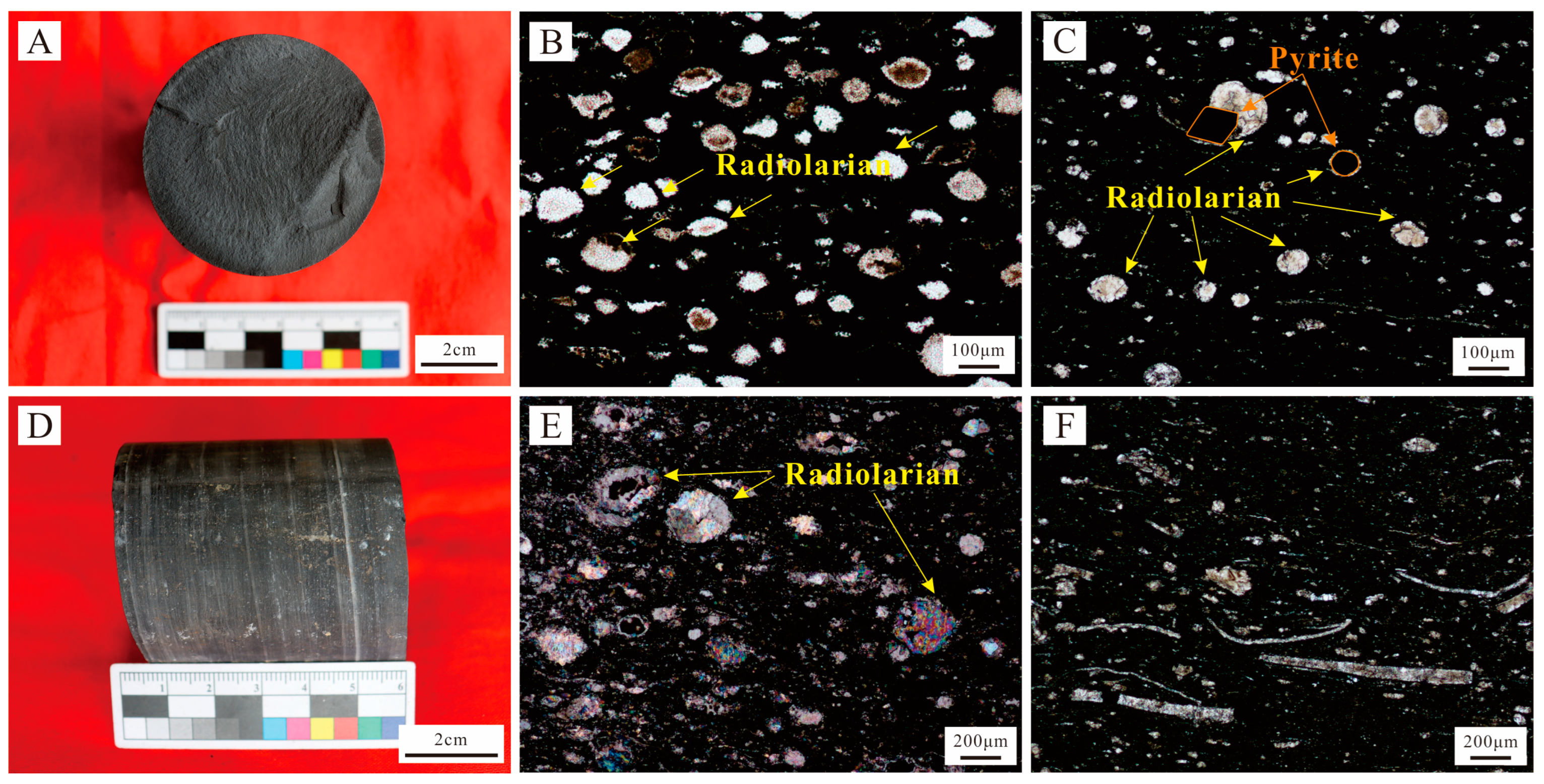

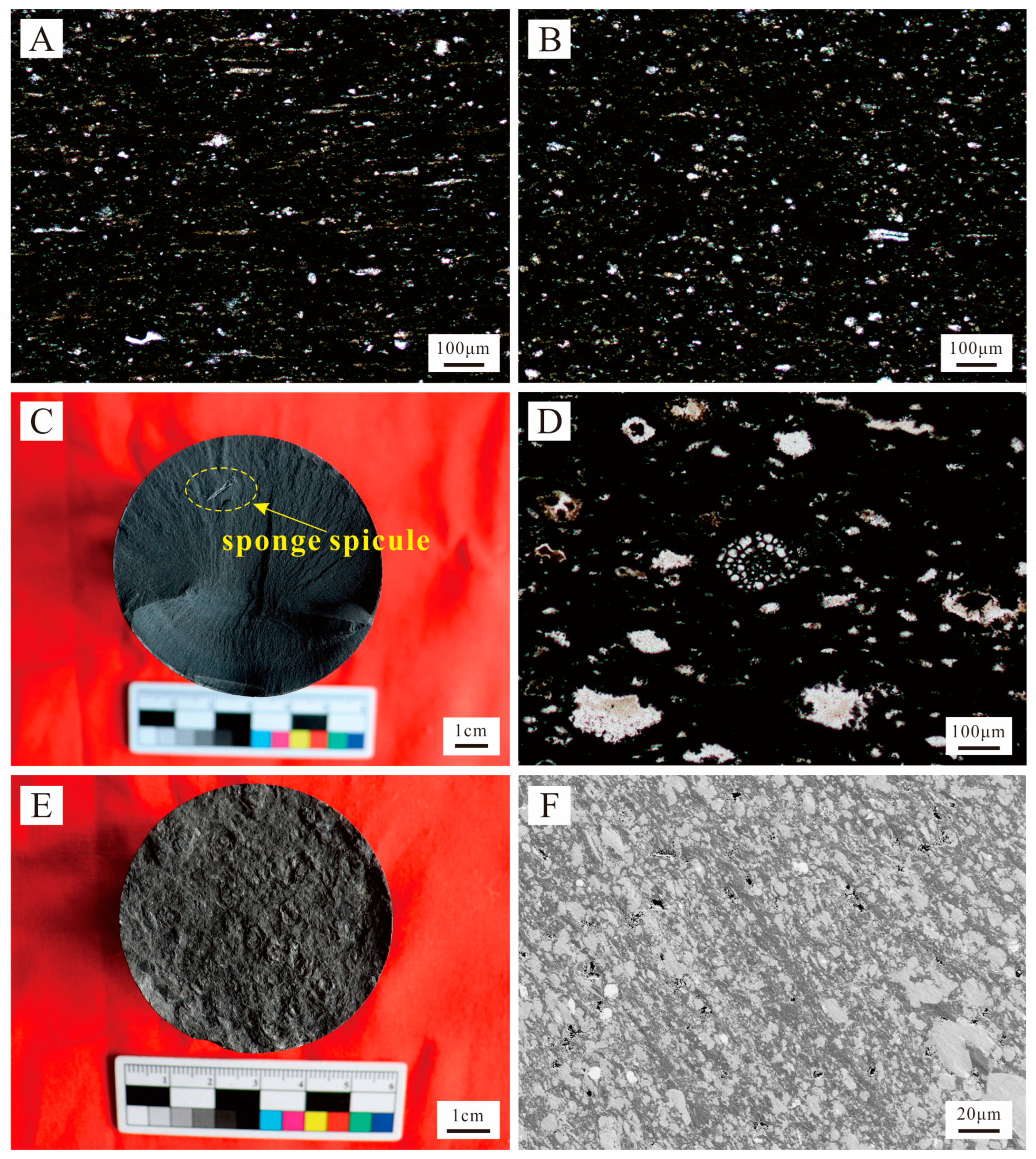
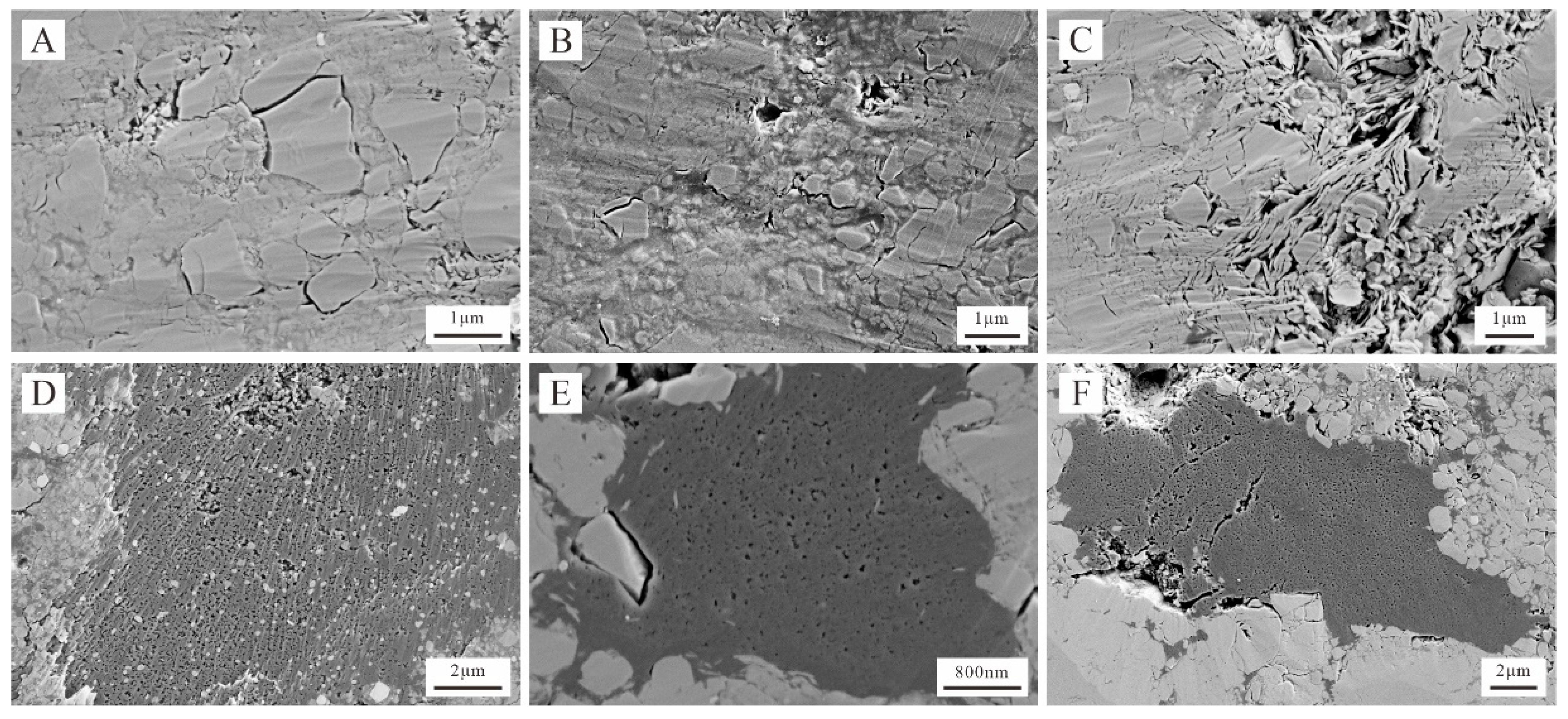
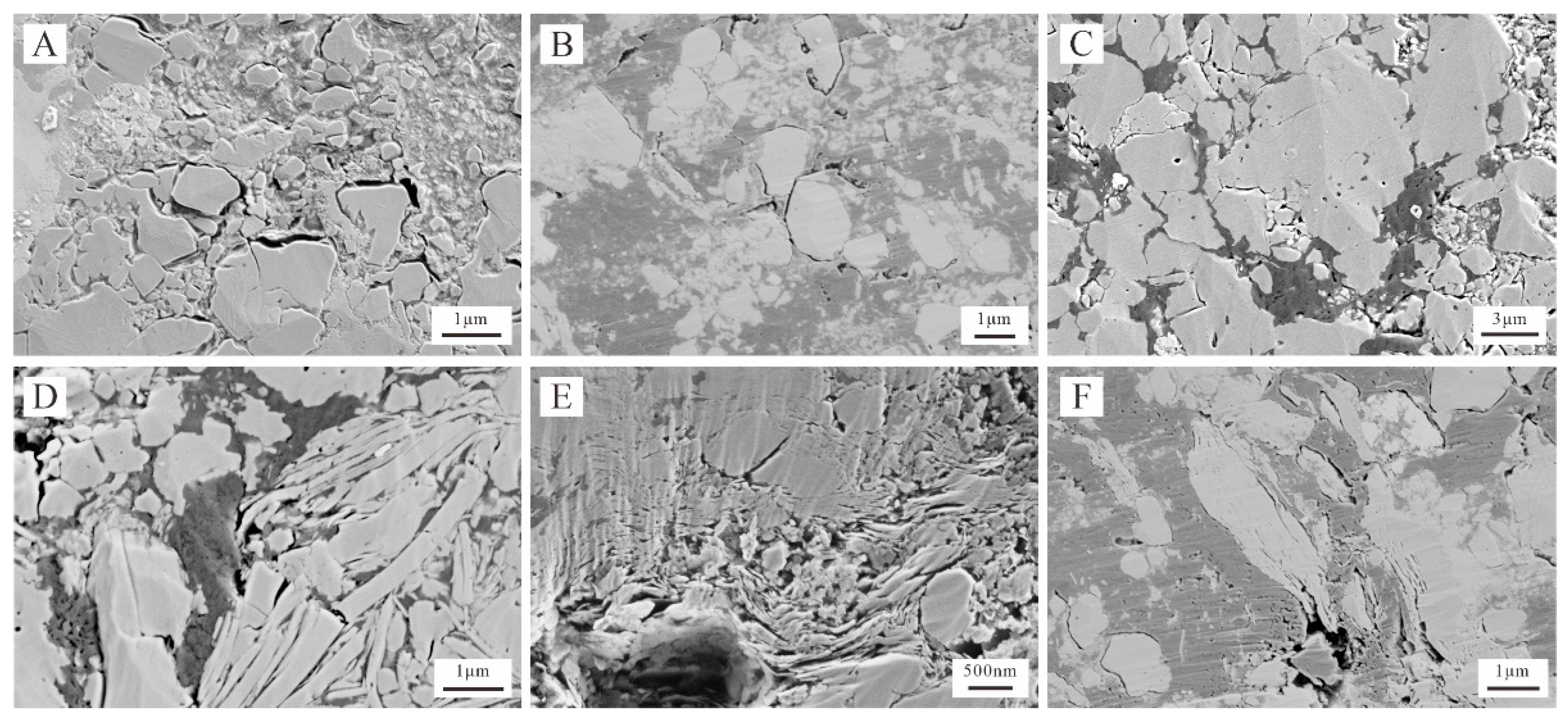
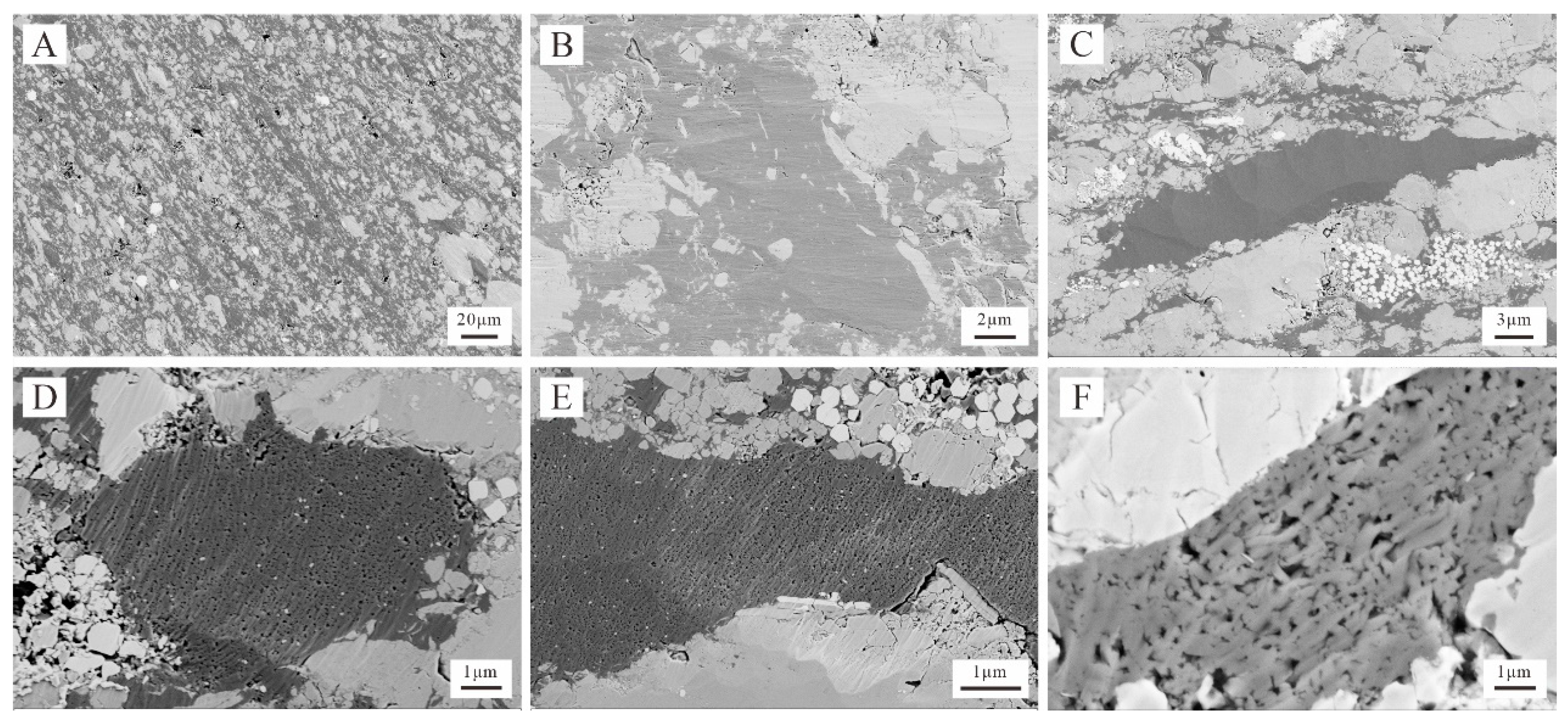
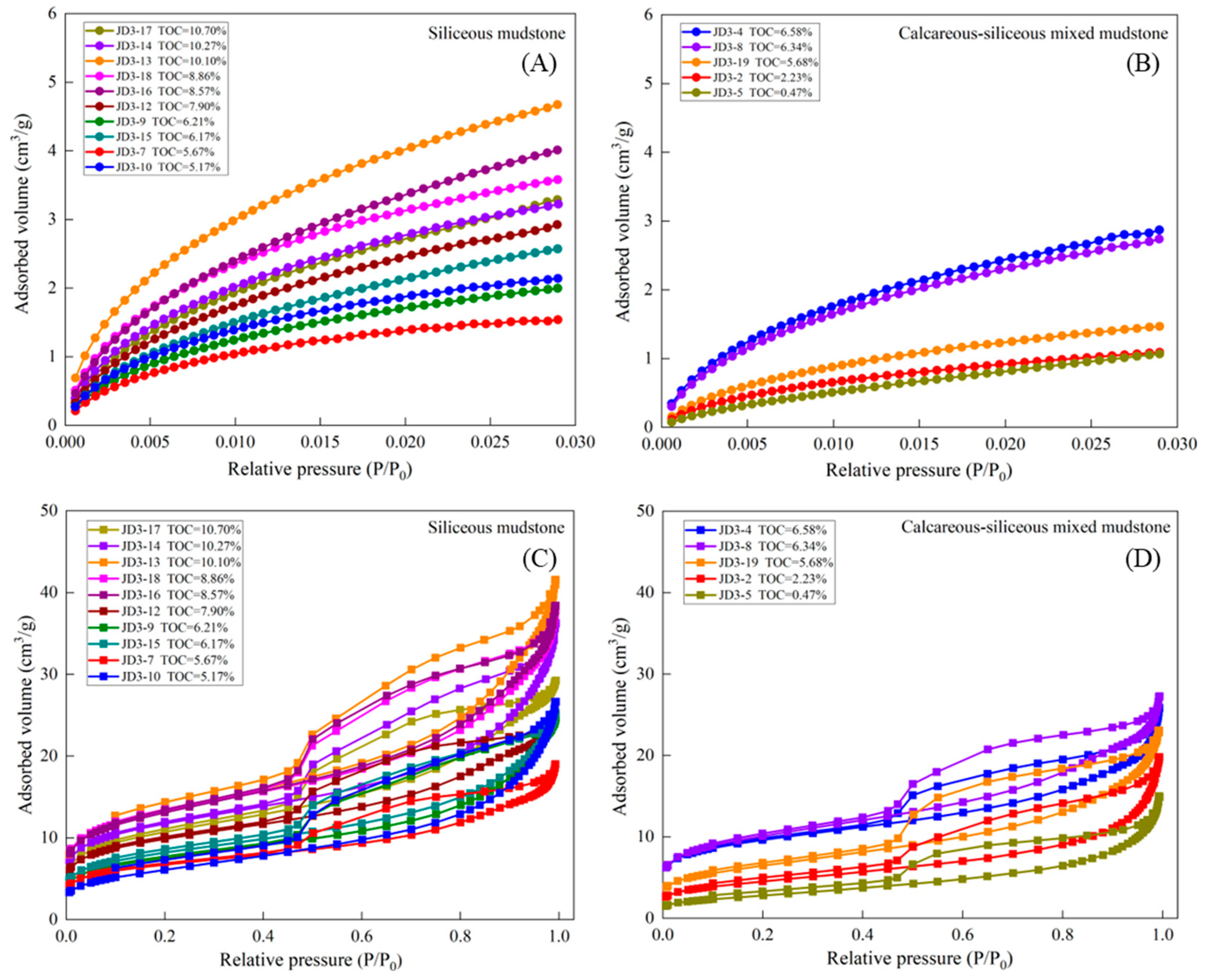
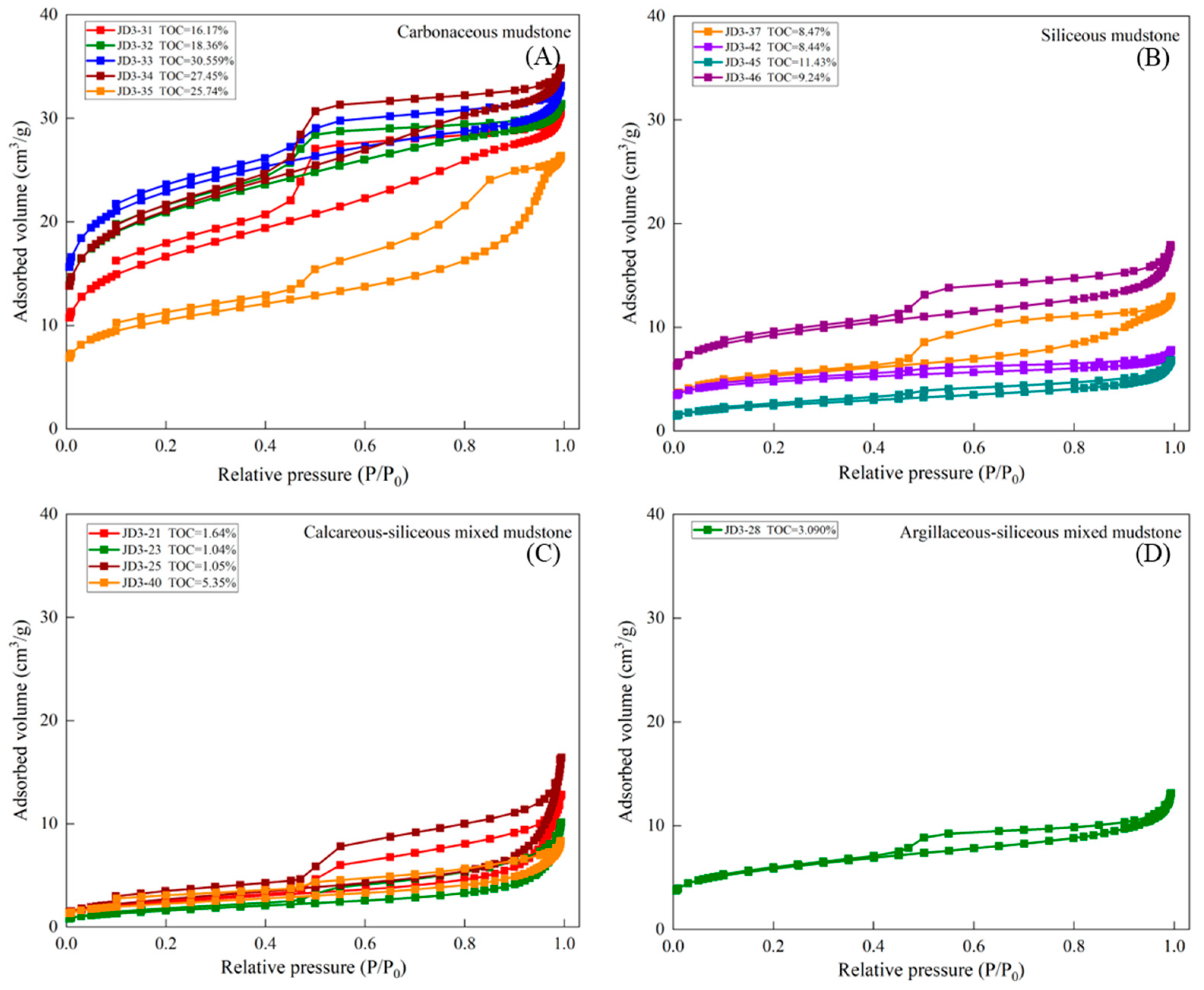
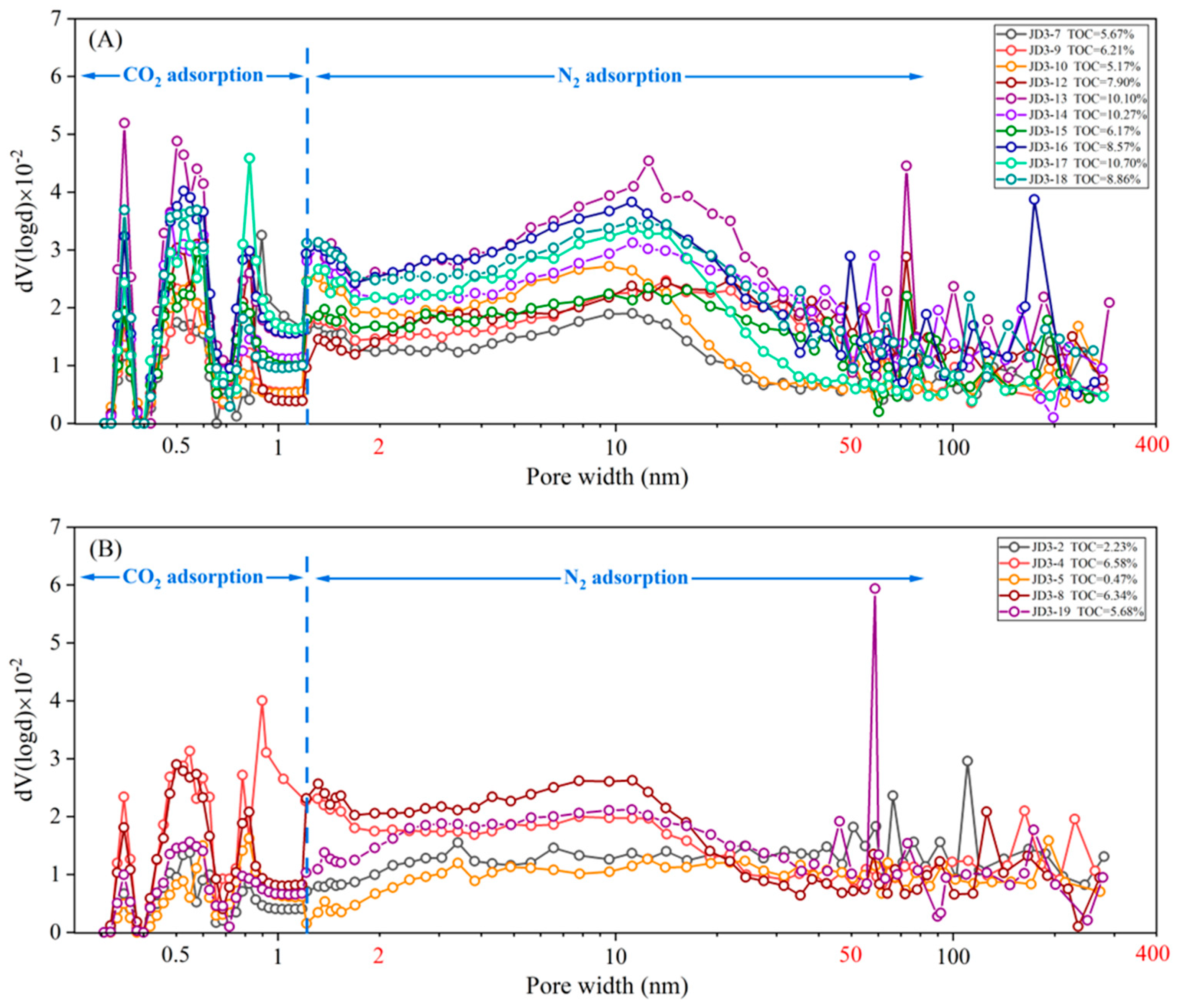
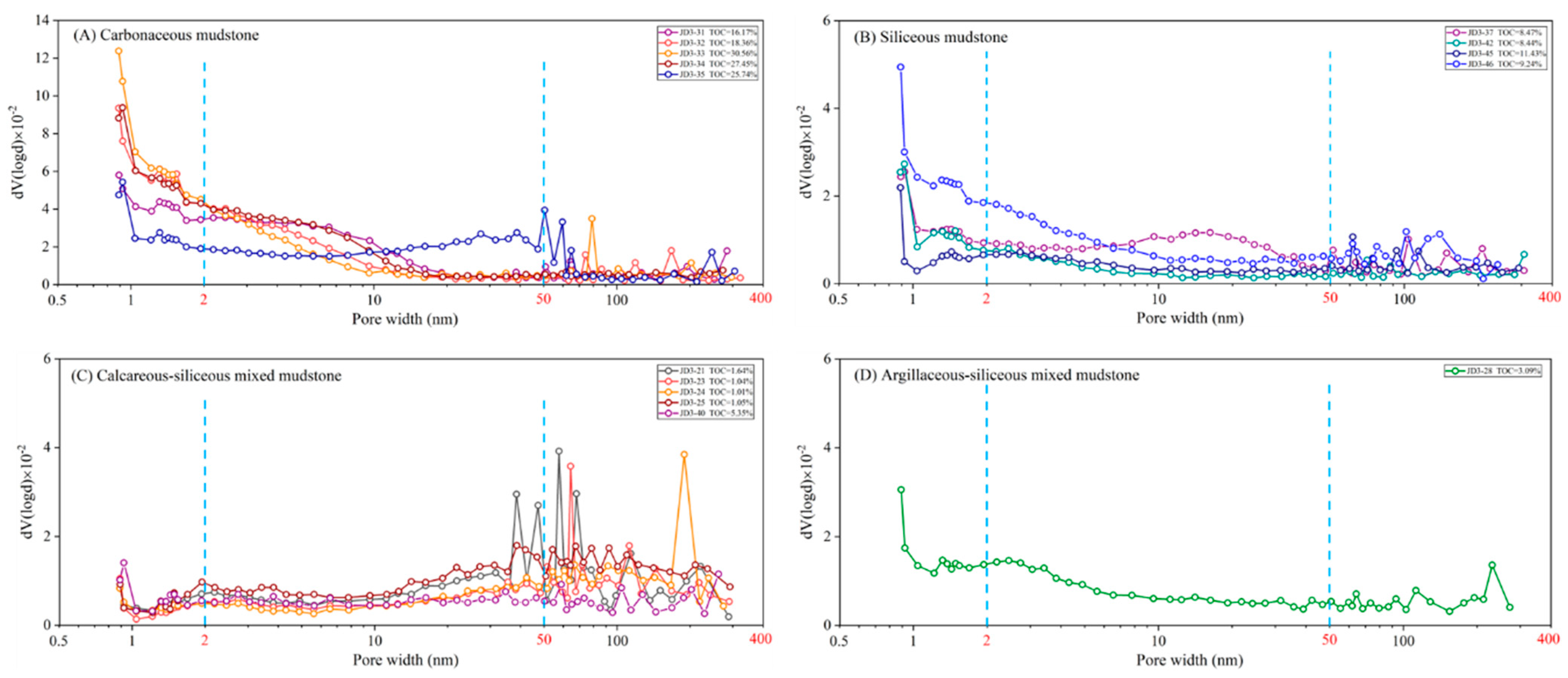
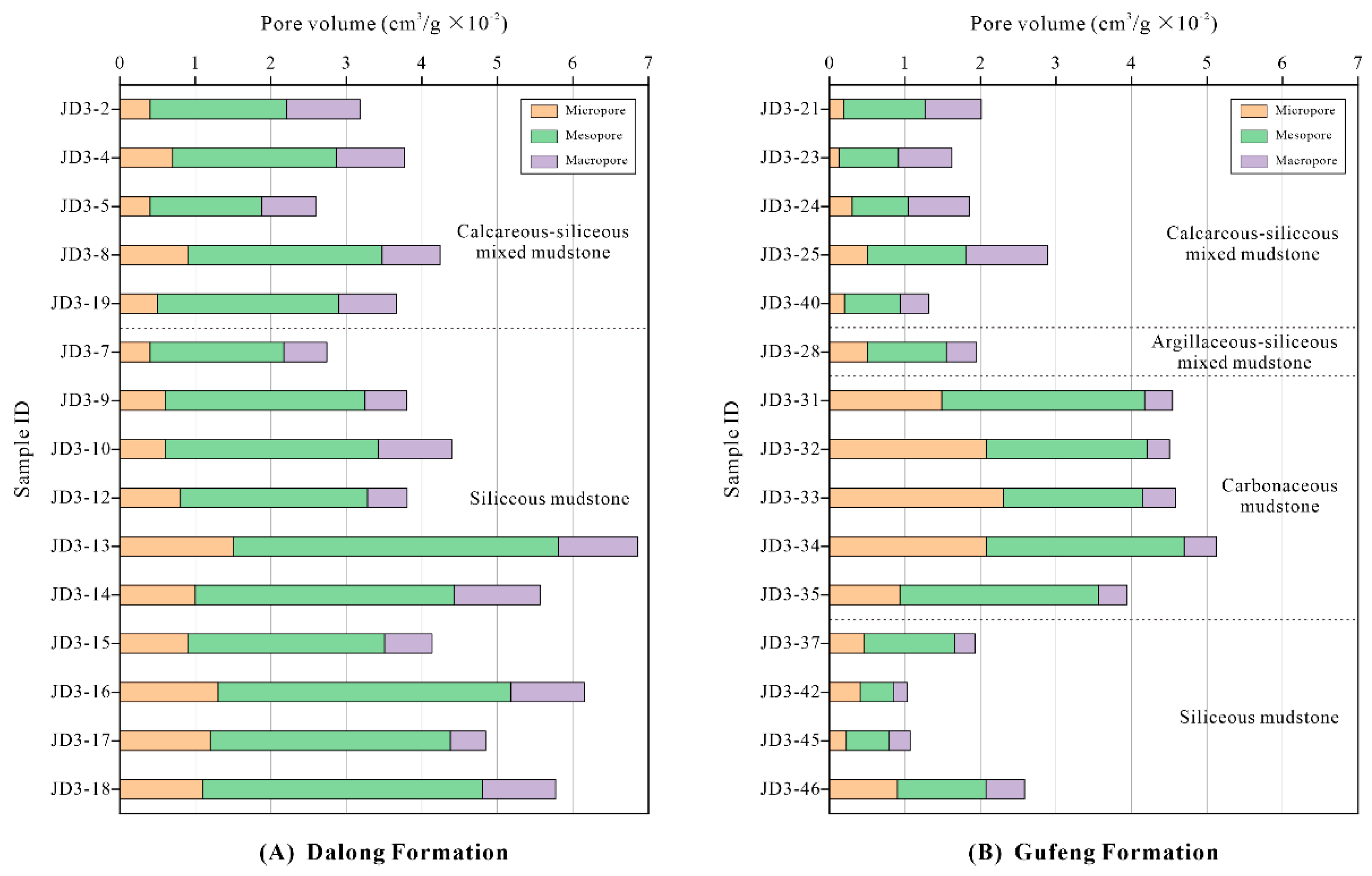
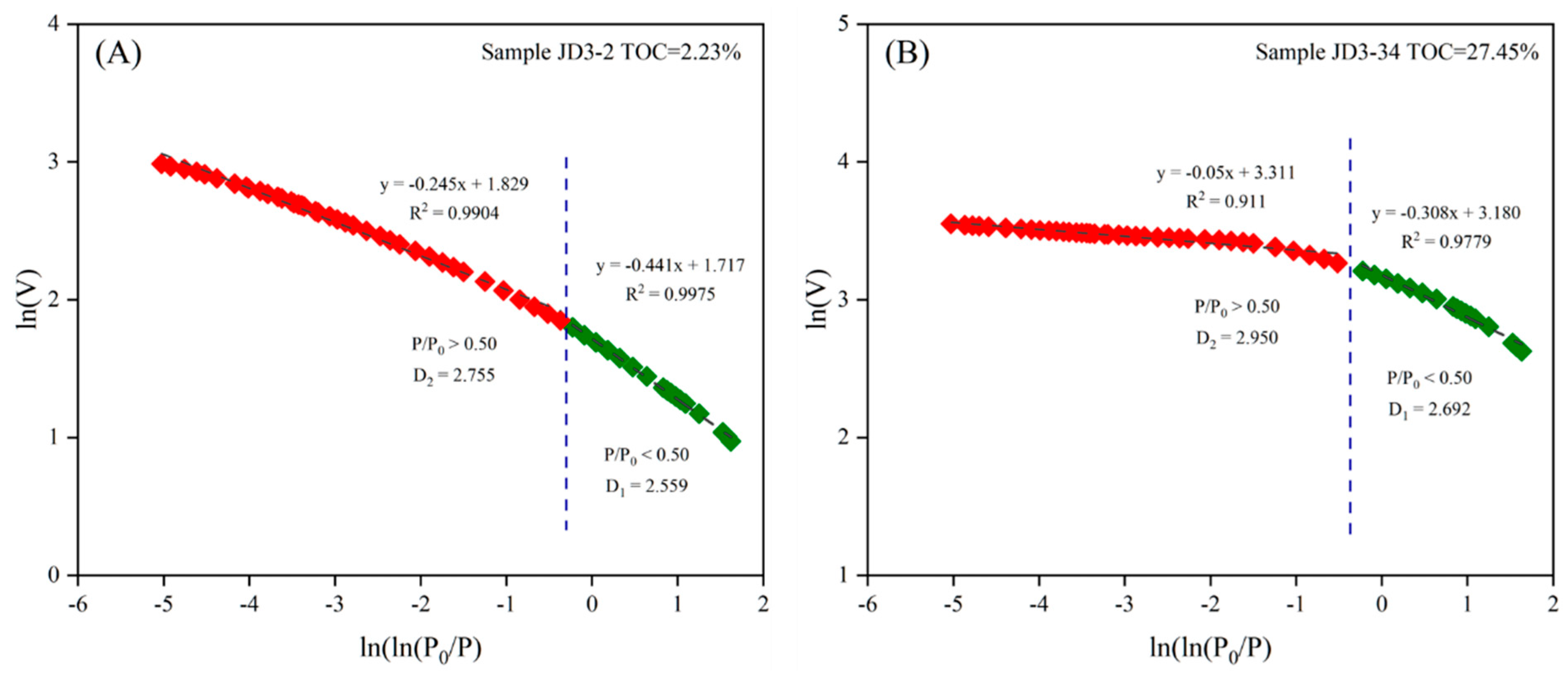

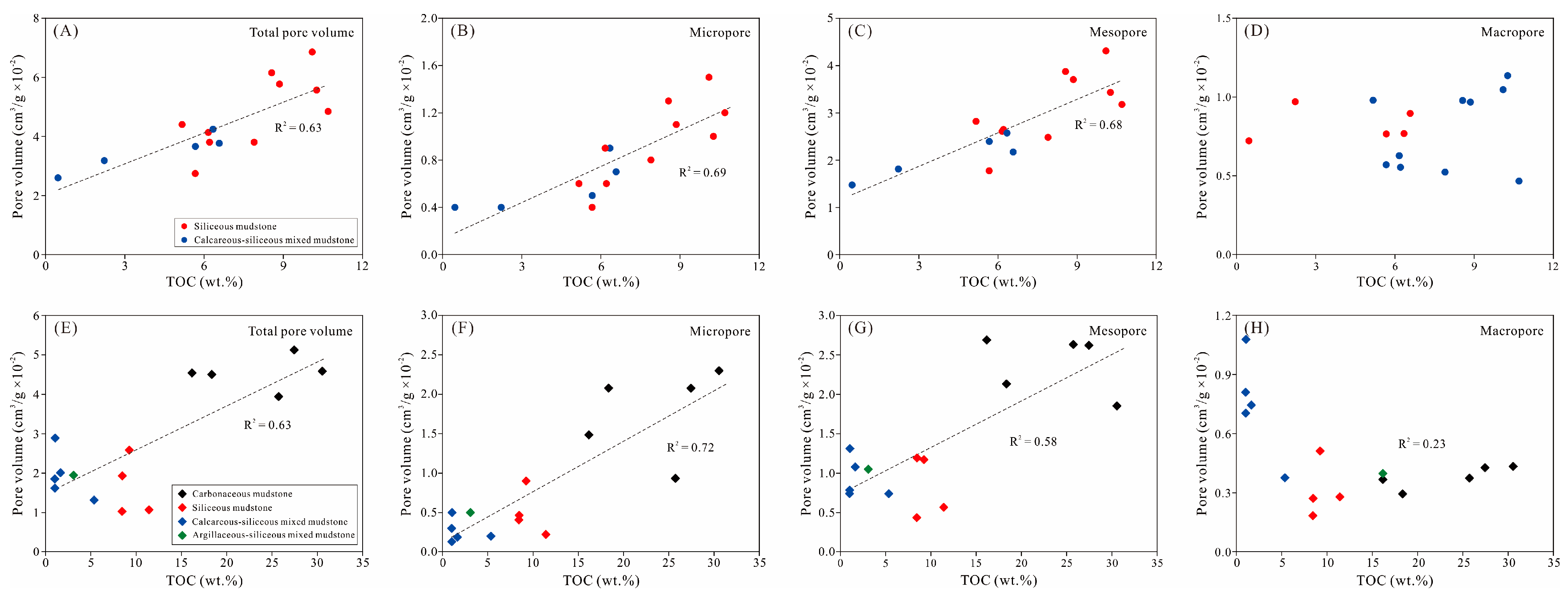
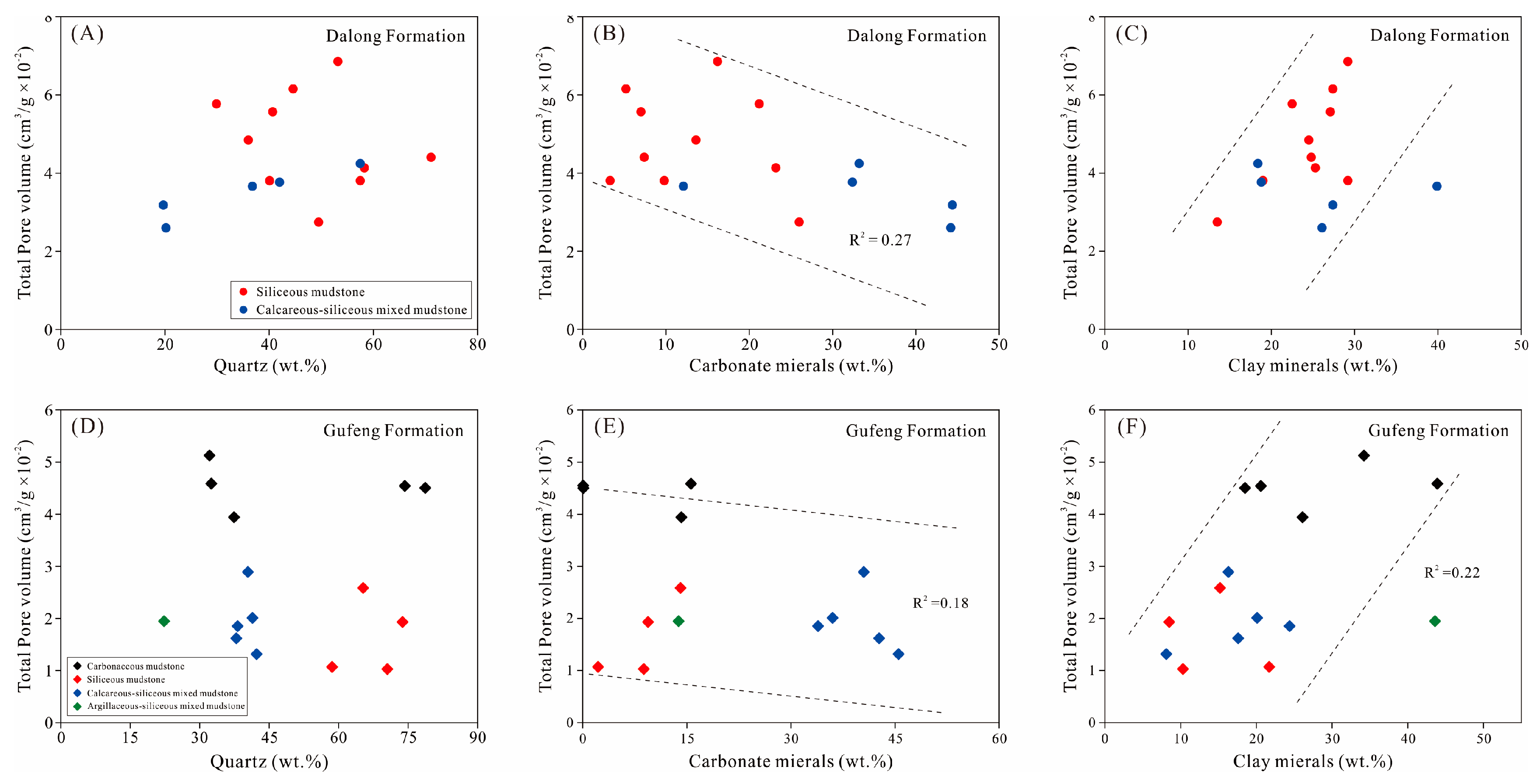

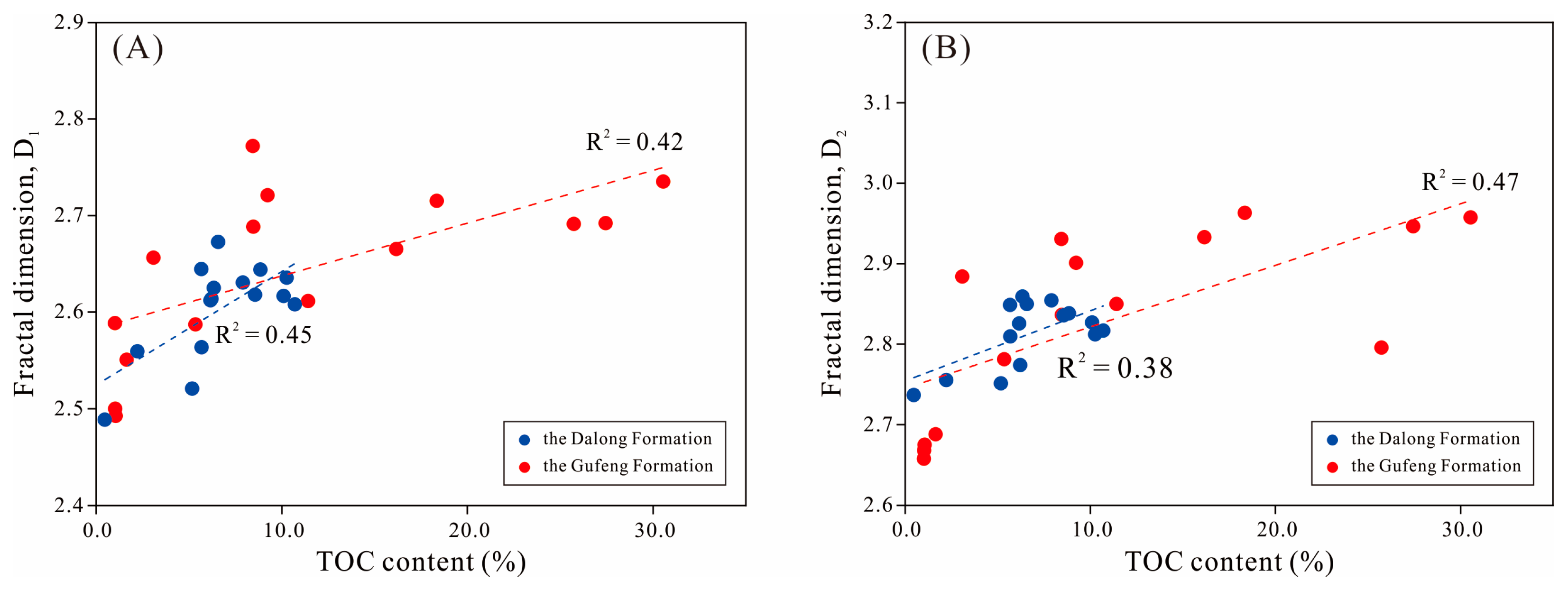

| Sample ID | Depth | Formation | TOC | Lithofacies | Pore Volume (cm3/g × 10−2) | Surface Area (m2/g) | ||||||
|---|---|---|---|---|---|---|---|---|---|---|---|---|
| m | % | <2 nm | 2–50 nm | >50 nm | Total Pore Volume | <2 nm | 2–50 nm | >50 nm | Total Surface Area | |||
| JD3-2 | 335.40 | Dalong | 2.23 | Mixed mudstone | 0.40 | 1.812 | 0.970 | 3.182 | 11.628 | 10.300 | 0.400 | 22.328 |
| JD3-4 | 339.25 | Dalong | 6.58 | Calcareous/siliceous mixed mudstone | 0.70 | 2.172 | 0.896 | 3.768 | 26.858 | 14.071 | 0.324 | 41.253 |
| JD3-5 | 340.50 | Dalong | 0.47 | Mixed mudstone | 0.40 | 1.476 | 0.722 | 2.598 | 11.925 | 8.1687 | 0.27 | 20.364 |
| JD3-7 | 343.40 | Dalong | 5.67 | Calcareous-rich siliceous mudstone | 0.40 | 1.773 | 0.570 | 2.743 | 14.731 | 11.079 | 0.206 | 26.016 |
| JD3-8 | 345.80 | Dalong | 6.34 | Calcareous/siliceous mixed mudstone | 0.90 | 2.573 | 0.768 | 4.241 | 28.439 | 17.308 | 0.27 | 46.017 |
| JD3-9 | 348.20 | Dalong | 6.21 | Siliceous mudstone | 0.60 | 2.648 | 0.554 | 3.802 | 20.702 | 14.049 | 0.231 | 34.982 |
| JD3-10 | 350.90 | Dalong | 5.17 | Siliceous mudstone | 0.60 | 2.821 | 0.979 | 4.400 | 22.067 | 15.397 | 0.396 | 37.860 |
| JD3-12 | 355.80 | Dalong | 7.90 | Siliceous mudstone | 0.80 | 2.480 | 0.523 | 3.804 | 28.947 | 16.456 | 0.187 | 45.590 |
| JD3-13 | 357.90 | Dalong | 10.10 | Siliceous mudstone | 1.50 | 4.311 | 1.046 | 6.857 | 49.504 | 24.776 | 0.409 | 74.689 |
| JD3-14 | 360.40 | Dalong | 10.27 | Siliceous mudstone | 1.00 | 3.432 | 1.136 | 5.568 | 34.014 | 19.223 | 0.431 | 53.668 |
| JD3-15 | 362.30 | Dalong | 6.17 | Siliceous mudstone | 0.90 | 2.607 | 0.627 | 4.134 | 27.383 | 15.134 | 0.258 | 42.775 |
| JD3-16 | 365.75 | Dalong | 8.57 | Siliceous mudstone | 1.30 | 3.874 | 0.978 | 6.152 | 42.988 | 23.726 | 0.365 | 67.079 |
| JD3-17 | 366.50 | Dalong | 10.70 | Siliceous mudstone | 1.20 | 3.177 | 0.466 | 4.844 | 37.078 | 19.852 | 0.174 | 57.104 |
| JD3-18 | 368.75 | Dalong | 8.86 | Siliceous mudstone | 1.10 | 3.704 | 0.967 | 5.771 | 37.405 | 21.997 | 0.37 | 59.772 |
| JD3-19 | 370.00 | Dalong | 5.68 | Siliceous/argillaceous mixed mudstone | 0.50 | 2.396 | 0.766 | 3.661 | 16.020 | 14.761 | 0.316 | 31.097 |
| JD3-21 | 428.10 | Gufeng | 1.64 | Calcareous/siliceous mixed mudstone | 0.19 | 1.078 | 0.745 | 2.011 | 5.600 | 5.220 | 0.305 | 11.125 |
| JD3-23 | 433.40 | Gufeng | 1.04 | Calcareous/siliceous mixed mudstone | 0.13 | 0.786 | 0.704 | 1.619 | 3.879 | 4.030 | 0.266 | 8.175 |
| JD3-24 | 436.70 | Gufeng | 1.01 | Mixed mudstone | 0.30 | 0.742 | 0.810 | 1.852 | 9.802 | 3.467 | 0.308 | 13.577 |
| JD3-25 | 439.90 | Gufeng | 1.05 | Calcareous/siliceous mixed mudstone | 0.50 | 1.313 | 1.078 | 2.891 | 14.870 | 6.458 | 0.414 | 21.742 |
| JD3-28 | 448.25 | Gufeng | 3.09 | Siliceous/argillaceous mixed mudstone | 0.50 | 1.050 | 0.398 | 1.948 | 17.862 | 8.284 | 0.141 | 26.287 |
| JD3-31 | 454.85 | Gufeng | 16.17 | Carbonaceous mudstone | 1.49 | 2.689 | 0.368 | 4.542 | 46.692 | 23.222 | 0.131 | 70.045 |
| JD3-32 | 456.20 | Gufeng | 18.36 | Carbonaceous mudstone | 2.08 | 2.132 | 0.294 | 4.505 | 66.679 | 21.234 | 0.108 | 88.021 |
| JD3-33 | 458.75 | Gufeng | 30.56 | Carbonaceous mudstone | 2.30 | 1.853 | 0.434 | 4.587 | 78.258 | 18.537 | 0.158 | 96.953 |
| JD3-34 | 460.00 | Gufeng | 27.45 | Carbonaceous mudstone | 2.08 | 2.622 | 0.427 | 5.126 | 66.874 | 24.070 | 0.154 | 91.098 |
| JD3-35 | 462.15 | Gufeng | 25.74 | Carbonaceous mudstone | 0.93 | 2.633 | 0.375 | 3.941 | 30.217 | 14.044 | 0.180 | 44.441 |
| JD3-37 | 465.70 | Gufeng | 8.47 | Siliceous mudstone | 0.47 | 1.195 | 0.272 | 1.932 | 15.104 | 7.089 | 0.097 | 22.290 |
| JD3-40 | 470.40 | Gufeng | 5.35 | Calcareous/siliceous mixed mudstone | 0.20 | 0.739 | 0.377 | 1.316 | 8.613 | 4.340 | 0.145 | 13.098 |
| JD3-42 | 473.40 | Gufeng | 8.44 | Siliceous mudstone | 0.41 | 0.437 | 0.184 | 1.029 | 13.331 | 3.853 | 0.064 | 17.248 |
| JD3-45 | 476.35 | Gufeng | 11.43 | Siliceous mudstone | 0.22 | 0.568 | 0.279 | 1.070 | 6.968 | 4.276 | 0.104 | 11.348 |
| JD3-46 | 477.35 | Gufeng | 9.24 | Siliceous mudstone | 0.90 | 1.172 | 0.512 | 2.584 | 33.916 | 9.606 | 0.197 | 43.719 |
| Sample | Depth (m) | TOC (wt.%) | P/P0 < 0.50 | P/P0 > 0.50 | ||||
|---|---|---|---|---|---|---|---|---|
| Fitting Equation | D1 | R2 | Fitting Equation | D2 | R2 | |||
| JD3-2 | 335.40 | 2.23 | y = −0.4406x + 1.7174 | 2.559 | 0.9975 | y = −0.2449x + 1.8295 | 2.755 | 0.9904 |
| JD3-4 | 339.25 | 6.58 | y = −0.3273x + 2.4035 | 2.673 | 0.9856 | y = −0.1502x + 2.5248 | 2.850 | 0.9782 |
| JD3-5 | 340.50 | 0.47 | y = −0.5115x + 1.2781 | 2.489 | 0.9991 | y = −0.2633x + 1.4673 | 2.737 | 0.9790 |
| JD3-7 | 343.40 | 5.67 | y = −0.3554x + 2.0597 | 2.645 | 0.9852 | y = −0.1513x + 2.2383 | 2.849 | 0.9412 |
| JD3-8 | 345.80 | 6.34 | y = −0.3749x + 2.4804 | 2.625 | 0.9883 | y = −0.1411x + 2.6466 | 2.859 | 0.9325 |
| JD3-9 | 348.20 | 6.21 | y = −0.3862x + 2.1911 | 2.614 | 0.9869 | y = −0.3862x + 2.1911 | 2.774 | 0.9869 |
| JD3-10 | 350.90 | 5.17 | y = −0.4793x + 2.0241 | 2.521 | 0.9960 | y = −0.2489x + 2.1934 | 2.751 | 0.9690 |
| JD3-12 | 355.80 | 7.90 | y = −0.3695x + 2.4539 | 2.631 | 0.9844 | y = −0.1456x + 2.6074 | 2.854 | 0.9047 |
| JD3-13 | 357.90 | 10.10 | y = −0.3833x + 2.7564 | 2.617 | 0.9878 | y = −0.1732x + 2.9584 | 2.827 | 0.9212 |
| JD3-14 | 360.40 | 10.27 | y = −0.3644x + 2.6232 | 2.636 | 0.9847 | y = −0.1881x + 2.7359 | 2.812 | 0.9606 |
| JD3-15 | 362.30 | 6.17 | y = −0.3879x + 2.2722 | 2.612 | 0.9882 | y = −0.1745x + 2.455 | 2.826 | 0.9405 |
| JD3-16 | 365.75 | 8.57 | y = −0.382x + 2.7454 | 2.618 | 0.9889 | y = −0.1643x + 2.9137 | 2.836 | 0.9306 |
| JD3-17 | 366.50 | 10.70 | y = −0.392x + 2.5468 | 2.608 | 0.9879 | y = −0.1834x + 2.6833 | 2.817 | 0.9199 |
| JD3-18 | 368.75 | 8.86 | y = −0.3561x + 2.736 | 2.644 | 0.9865 | y = −0.1617x + 2.9061 | 2.838 | 0.9382 |
| JD3-19 | 370.00 | 5.68 | y = −0.4366x + 2.0654 | 2.563 | 0.9966 | y = −0.1904x + 2.2783 | 2.810 | 0.9578 |
| JD3-21 | 428.10 | 1.64 | y = −0.4494x + 1.0798 | 2.551 | 0.9957 | y = −0.3121x + 1.0842 | 2.688 | 0.9898 |
| JD3-23 | 433.40 | 1.04 | y = −0.5002x + 0.6907 | 2.500 | 0.9967 | y = −0.3319x + 0.7002 | 2.668 | 0.9982 |
| JD3-24 | 436.70 | 1.01 | y = −0.4115x + 0.8098 | 2.589 | 0.9934 | y = −0.3423x + 0.7121 | 2.658 | 0.9956 |
| JD3-25 | 439.90 | 1.05 | y = −0.5075x + 1.2136 | 2.493 | 0.9975 | y = −0.325x + 1.2257 | 2.675 | 0.9951 |
| JD3-28 | 448.25 | 3.09 | y = −0.3437x + 1.9205 | 2.656 | 0.9919 | y = −0.116x + 1.9952 | 2.884 | 0.9938 |
| JD3-31 | 454.85 | 16.17 | y = −0.3347x + 2.9588 | 2.665 | 0.9873 | y = −0.0671x + 3.1186 | 2.933 | 0.8576 |
| JD3-32 | 456.20 | 18.36 | y = −0.2849x + 3.1535 | 2.715 | 0.9740 | y = −0.037x + 3.2667 | 2.963 | 0.9285 |
| JD3-33 | 458.75 | 30.56 | y = −0.2648x + 3.2388 | 2.735 | 0.9660 | y = −0.0426x + 3.2843 | 2.957 | 0.9844 |
| JD3-34 | 460.00 | 27.45 | y = −0.3079x + 3.1802 | 2.692 | 0.9779 | y = −0.0537x + 3.2975 | 2.946 | 0.8965 |
| JD3-35 | 462.15 | 25.74 | y = −0.3088x + 2.4812 | 2.691 | 0.9839 | y = −0.2045x + 2.4934 | 2.796 | 0.9842 |
| JD3-37 | 465.70 | 8.47 | y = −0.3116x + 1.8051 | 2.688 | 0.9849 | y = −0.1636x + 1.8787 | 2.836 | 0.9494 |
| JD3-40 | 470.40 | 5.35 | y = −0.4127x + 1.0012 | 2.587 | 0.9945 | y = −0.219x + 1.079 | 2.781 | 0.9914 |
| JD3-42 | 473.40 | 8.44 | y = −0.2281x + 1.6533 | 2.772 | 0.9763 | y = −0.0694x + 1.6873 | 2.931 | 0.9954 |
| JD3-45 | 476.35 | 11.43 | y = −0.3886x + 1.0697 | 2.611 | 0.9941 | y = −0.1503x + 1.1654 | 2.850 | 0.9984 |
| JD3-46 | 477.35 | 9.24 | y = −0.2791x + 2.3399 | 2.721 | 0.9788 | y = −0.0992x + 2.3781 | 2.901 | 0.9935 |
Disclaimer/Publisher’s Note: The statements, opinions and data contained in all publications are solely those of the individual author(s) and contributor(s) and not of MDPI and/or the editor(s). MDPI and/or the editor(s) disclaim responsibility for any injury to people or property resulting from any ideas, methods, instructions or products referred to in the content. |
© 2023 by the authors. Licensee MDPI, Basel, Switzerland. This article is an open access article distributed under the terms and conditions of the Creative Commons Attribution (CC BY) license (https://creativecommons.org/licenses/by/4.0/).
Share and Cite
Wang, Y.; Zhang, Y.; Dong, T.; Duan, K.; Wen, J.; Zhang, H.; Xie, T.; Luo, F. Pore Structure and Fractal Characteristics of the Middle and Upper Permian Dalong and Gufeng Shale Reservoirs, Western Hubei Province, South China. Minerals 2024, 14, 10. https://doi.org/10.3390/min14010010
Wang Y, Zhang Y, Dong T, Duan K, Wen J, Zhang H, Xie T, Luo F. Pore Structure and Fractal Characteristics of the Middle and Upper Permian Dalong and Gufeng Shale Reservoirs, Western Hubei Province, South China. Minerals. 2024; 14(1):10. https://doi.org/10.3390/min14010010
Chicago/Turabian StyleWang, Yi, Yanlin Zhang, Tian Dong, Ke Duan, Jianhang Wen, Hao Zhang, Tong Xie, and Fan Luo. 2024. "Pore Structure and Fractal Characteristics of the Middle and Upper Permian Dalong and Gufeng Shale Reservoirs, Western Hubei Province, South China" Minerals 14, no. 1: 10. https://doi.org/10.3390/min14010010
APA StyleWang, Y., Zhang, Y., Dong, T., Duan, K., Wen, J., Zhang, H., Xie, T., & Luo, F. (2024). Pore Structure and Fractal Characteristics of the Middle and Upper Permian Dalong and Gufeng Shale Reservoirs, Western Hubei Province, South China. Minerals, 14(1), 10. https://doi.org/10.3390/min14010010





